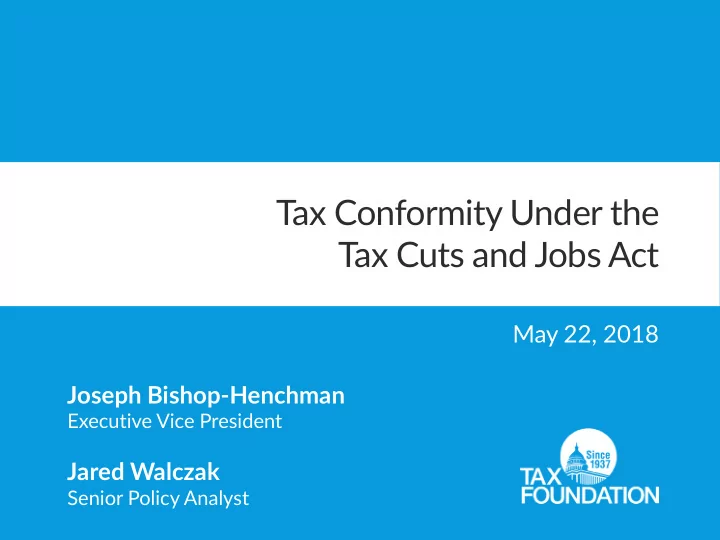

Tax Conformity Under the Tax Cuts and Jobs Act May 22, 2018 Joseph Bishop-Henchman Executive Vice President Jared Walczak Senior Policy Analyst
TAX CONFORMITY BRIEF HISTORY OF U.S. TAXES 1789 to 1909: U.S. government almost exclusively funded by • excise taxes, tariffs, and land sales. State governments funded by property taxes. 1909 to 1940s: U.S. government adopts corporate, individual • income, and payroll taxes. Individual income tax broadened to most people in 1942. States adopt sales taxes. 1964: Kennedy/Johnson tax cut. • 1969: AMT adopted. • 1981-86: Reagan tax bills, inc. 1986 reform. • Post 1986: Rates have moved around but no major structural • reform.
TAX CONFORMITY BRIEF HISTORY OF U.S. TAXES 1789 to 1909: U.S. government almost exclusively funded by • excise taxes, tariffs, and land sales. State governments funded by property taxes. 1909 to 1940s: U.S. government adopts corporate, individual • income, and payroll taxes. Individual income tax broadened to most people in 1942. States adopt sales taxes. 1964: Kennedy/Johnson tax cut. • 1969: AMT adopted. • 1981-86: Reagan tax bills, inc. 1986 reform. • Post 1986: Rates have moved around but no major structural • reform.
TAX CONFORMITY WHY TAX REFORM?
TAX CONFORMITY WHY TAX REFORM?
TAX CONFORMITY WHY TAX REFORM?
TAX CONFORMITY WHY TAX REFORM?
TAX CONFORMITY FEDERAL TAX BILL • Higher standard deduction • Repeal of personal exemption • Smaller itemized deductions (& fewer itemizers) • Pass-through deduction • Repatriation and international income • Interest deductibility and NOL changes • Pass-through and corporate expensing • Modification of business tax credits
TAX CONFORMITY BACKGROUND • States incorporate provisions of the federal tax code into their own codes to varying degrees, so federal reform has important implications for state revenue • Because base-broadening provisions of new law often flow through to states, while corresponding rate reductions do not, most—but not all!—states will experience a revenue increase • Federal reform creates both an opportunity and an impetus for state tax reform, with states responding in a variety of ways (retain, return, reform)
TAX CONFORMITY MAJOR REVENUE DRIVERS • Higher standard deduction – • Repeal of personal exemption + • Smaller itemized deductions (& fewer itemizers) + • Pass-through deduction – • Repatriation and international income + • Interest deductibility and NOL changes + • Pass-through and corporate expensing – • Modification of business tax credits +
TAX CONFORMITY CONFORMITY METHOD • Individual Rolling: 18 states + D.C. Static: 19 states Selective: 4 No PIT: 9 • Corporate Rolling: 22 states + D.C. Static: 21 states Selective: 2 No CIT: 5
TAX CONFORMITY FIVE SOURCES OF NEW REVENUE • There are at least five broad categories of ways that federal tax reform will drive state revenue changes • Only one of them requires states to conform to the latest (post-tax reform) version of the Internal Revenue Code—though it’s an important one
TAX CONFORMITY FIVE SOURCES OF NEW REVENUE • Income starting point for state tax calculations • Specific conformity provisions • Filing uniformity requirements • International income • Dynamic economic effects
TAX CONFORMITY FIVE SOURCES OF NEW REVENUE • Income starting point for state tax calculations
TAX CONFORMITY FIVE SOURCES OF NEW REVENUE • Income starting point for state tax calculations • Standard AGI: 29 states + D.C. • Including AZ, ID, NM, UT • Federal Taxable Income: 6 states • Including CO
TAX CONFORMITY FIVE SOURCES OF NEW REVENUE • Specific conformity provisions Standard deduction • Personal exemption • Itemized deductions • Mortgage interest, moving expenses, medical expenses, property taxes, etc. Cost recovery • Net operating loss provisions • Interest deductibility • Manufacturing expenses • Estate tax exemption •
TAX CONFORMITY FIVE SOURCES OF NEW REVENUE
TAX CONFORMITY FIVE SOURCES OF NEW REVENUE • Filing uniformity requirements Filing status linkage • Thirty-one states, including CO, ID, NM, UT Itemization linkage • Eight states plus D.C., including NM
TAX CONFORMITY FIVE SOURCES OF NEW REVENUE • International income Subpart F income • Thirteen states, including AZ, CO, ID Dividends Received Deduction • Twenty-six states plus D.C., including CO, NM New Federal Anti-Abuse Provisions • FDII, GILTI, and BEAT
TAX CONFORMITY FIVE SOURCES OF NEW REVENUE • Dynamic economic effects Some provisions of the new federal law are likely to • encourage additional domestic investment Temporary full expensing of short-lived capital • investments (machinery and equipment) Higher Section 179 limits • Lower corporate rate • Territorial taxation (cuts both ways) • This may lead to additional economic activity in states, • particularly if they optimize their tax codes for it
TAX CONFORMITY REVENUE IMPLICATIONS • States anticipating revenue gain AZ, CO, GA, ID, IN, IA, LA, ME, MD, MA, MI, MN, NE, NY, PA, SC, VT, WA, DC • States anticipating revenue loss MO – conforms to standard deduction but not personal exemption ND – incorporates pass-through deduction OR – incorporates pass-through deduction • Still waiting on revenue reports from other states Expectation is that all remaining states would see revenue gains
TAX CONFORMITY OPTIONS FOR STATES • Decouple from the pass-through deduction • Couple to new expensing rules • Enhance federal conformity • Use one-time revenues wisely • Enact comprehensive tax reform
TAX CONFORMITY THOUGHTS FOR UTAH • Future of the sales tax • Services growing as share of all sales • Taxation of business inputs creates distortions • Pressure to narrow tax base on consumption • Future of the corporate income tax • Will TCJA reverse trend toward pass-throughs? • Future of the property tax • Stable, huge, and unpopular: many states cap • Future of the individual income tax • What will Congress do in 2025?
TAX CONFORMITY QUESTIONS? Joseph Bishop-Henchman Executive Vice President Jared Walczak Senior Policy Analyst
Recommend
More recommend